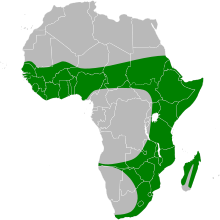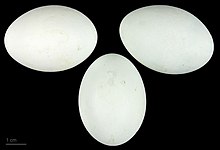Bell heron
| Bell heron | ||||||||||||
|---|---|---|---|---|---|---|---|---|---|---|---|---|

Winged bell heron |
||||||||||||
| Systematics | ||||||||||||
|
||||||||||||
| Scientific name | ||||||||||||
| Egretta ardesiaca | ||||||||||||
| ( Wagler , 1827) |
The bell heron ( Egretta ardesiaca ) is a species from the heron family . It occurs exclusively in Africa . While foraging for food, it spreads its wings like an umbrella ( wing sheaths ), which has led to the German name bell heron.
Appearance
The bell heron is one of the medium-sized heron species. He reaches a height of 42 to 66 centimeters and weighs 270 to 390 grams. There is no gender dimorphism . It is not a particularly shouting type. Only soft clicks are described for this type.
Compared to other species of the genus Egretta, the heron appears rather compact. The plumage is slate black. At the back of the head there are lancet-shaped elongated feathers that form a feather head. The beak is black, the iris is dark brown and the eyes are surrounded by a narrow powder blue eye ring. The feet are yellow to orange. It differs from the very similar brown-throated and red-bellied heron in its uniformly dark plumage, black legs and yellow feet.
Distribution area, population and habitat
The distribution area of the bell heron extends over Africa and Madagascar. In Africa it occurs south of the Sahara. It is absent in the deserts and in the dense rainforests of West and Central Africa. Its habitat are wetlands and the edge areas of lakes. Within its large distribution area there are larger distribution gaps, although suitable habitats can be found there. In Kenya, for example, it only breeds in one place. Migration occurs again and again when individual regions no longer offer suitable living conditions. As a result of these migratory movements, it is occasionally observed in places that are outside its normal range. So it appears sporadically in Egypt and Yemen.
There are very large populations in individual regions of Africa. The population in Tanzania is estimated at 5,000 to 7,000 bell herons. This population appears to be relatively stable, although its habitat has changed significantly due to increasing human population. In Madagascar, on the other hand, the numbers of bell herons are falling very sharply. In 1992 there were still 2,000 bell herons in Madagascar, in 1997 only 250 were counted.
The bell heron is not a habitat specialist. It only needs open shallow water and occurs inland on swamps, rivers, rice fields and seasonally flooded plains. On the coast it looks for food at estuaries and in mangroves as well as in the tidal zone. Its altitude distribution extends from the lowlands to 1500 meters in altitude on Madagascar.
Way of life
The bell heron has a very noticeable form of diet. It moves to a point in the shallow water zone where it suspects prey and then spreads its wings like an umbrella over its head so that the tips of the wings touch the water. In this position he searches for food for two or three seconds. He often stirs up the ground with his feet. Fish are then grabbed with one quick movement. Then he folds the wings together, takes a few steps and opens the wings again like an umbrella. The reasons for this movement sequence are the glare-free view of what is happening under water and the instinctive flight of the fish into shaded water areas that are normally formed by plants.
Individual bell herons have a food territory that they defend from other species. Other bell herons look for food together. In Madagascar flocks of bell herons comprising 250 individuals have been observed foraging for food. The food spectrum of the bell heron consists mainly of fish, but it also eats aquatic insects and crustaceans.
The breeding season begins with the onset of the rainy season and varies accordingly depending on its range. It typically nests in colonies with 50 to 100 other pairs of bell herons. The clutch consists of two to four eggs. Otherwise very little is known about the breeding biology.
supporting documents
Single receipts
- ↑ adapted from: Kushlan, James A. and James A. Hancock, Herons, Oxford; New York: Oxford University Press, 2005. ISBN 9780198549819
- ↑ Kushlan et al., P. 163
- ↑ Kushlan et al., P. 163
- ↑ Kushlan et al., P. 164
- ↑ Kushlan et al., P. 164
- ↑ Kushlan et al., P. 164
- ↑ Archive link ( Memento of the original from July 26, 2010 in the Internet Archive ) Info: The archive link was inserted automatically and has not yet been checked. Please check the original and archive link according to the instructions and then remove this notice.
literature
- James A. Kushlan & James A. Hancock: Herons . Oxford University Press, 2005, ISBN 0198549814
Web links
- Egretta ardesiaca inthe IUCN Red List of Threatened Species 2013.1. Listed by: BirdLife International, 2012. Retrieved November 21, 2013.

